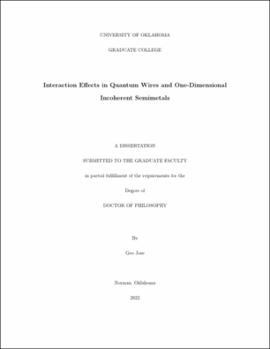| dc.contributor.advisor | Uchoa, Bruno | |
| dc.contributor.author | Jose, Geo | |
| dc.date.accessioned | 2022-07-17T18:02:05Z | |
| dc.date.available | 2022-07-17T18:02:05Z | |
| dc.date.issued | 2022-08-04 | |
| dc.identifier.uri | https://hdl.handle.net/11244/335941 | |
| dc.description.abstract | In this thesis, we address the effect of interactions in low dimensional
systems. In the first part, using bosonization, we study a microscopic
model of parallel quantum wires constructed from two dimensional Dirac
fermions in the presence of periodic topological domain walls. The
model accounts for the lateral spread of the wave-functions $\ell$
in the transverse direction to the wires. The gapless modes confined
to each domain wall are shown to form Luttinger liquids, which realize
a well known smectic non-Fermi liquid fixed point when inter-wire
Coulomb interactions are taken into account. Perturbative studies
on phenomenological models have shown that the smectic fixed point
is unstable towards a variety of phases such as superconductivity,
stripe, smectic and Fermi liquid phases. Here, we show that the considered
microscopic model leads to a phase diagram with only smectic metal
and Fermi liquid phases. The smectic metal phase is stable in the
ideal quantum wire limit $\ell\to0$. For finite $\ell$, we find
a critical Coulomb coupling $\alpha_{c}$ separating the strong coupling
smectic metal from a weak coupling Fermi liquid phase. We conjecture
that the absence of superconductivity should be a generic feature
of similar microscopic models. We also discuss the physical realization
of this model with moiré heterostructures. In particular, our model
may be of relevance to recent experiments on twisted bilayer $\mathrm{tWTe_{2}.}$
In the second part we study a two band dispersive Sachdev-Ye-Kitaev
model in 1+1 dimension. We suggest a model that describes a semimetal
with quadratic dispersion at half-filling. We compute the Green's
function at the saddle point using a combination of analytical and
numerical methods. Employing a scaling symmetry of the Schwinger-Dyson
equations that becomes transparent in the strongly dispersive limit,
we show that the exact solution of the problem yields a distinct type
of non-Fermi liquid with sub-linear $\rho\propto T^{2/5}$ temperature
dependence of the resistivity. A scaling analysis indicates that this
state corresponds to the fixed point of the dispersive SYK model for
a quadratic band touching semimetal. | en_US |
| dc.language | en_US | en_US |
| dc.rights | Attribution-NonCommercial-NoDerivatives 4.0 International | * |
| dc.rights.uri | https://creativecommons.org/licenses/by-nc-nd/4.0/ | * |
| dc.subject | Theoretical Physics | en_US |
| dc.subject | Condensed Matter | en_US |
| dc.subject | Strongly correlated | en_US |
| dc.title | Interaction Effects in Quantum Wires and One-Dimensional Incoherent Semimetals | en_US |
| dc.contributor.committeeMember | Przebinda, Tomasz | |
| dc.contributor.committeeMember | Mullen, Kieran | |
| dc.contributor.committeeMember | Santos, Michael | |
| dc.contributor.committeeMember | Baer, Howard | |
| dc.date.manuscript | 2022-07-14 | |
| dc.thesis.degree | Ph.D. | en_US |
| ou.group | Dodge Family College of Arts and Sciences::Homer L. Dodge Department of Physics and Astronomy | en_US |
| shareok.nativefileaccess | restricted | en_US |

